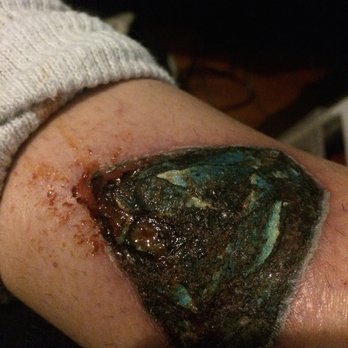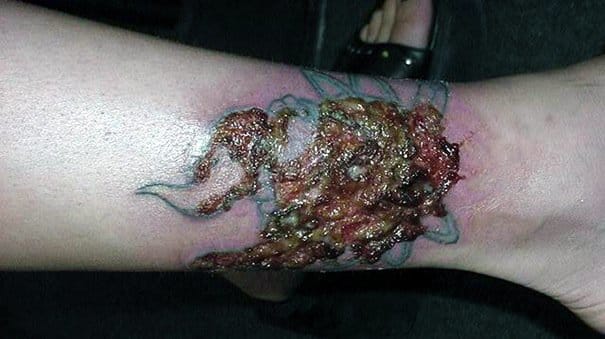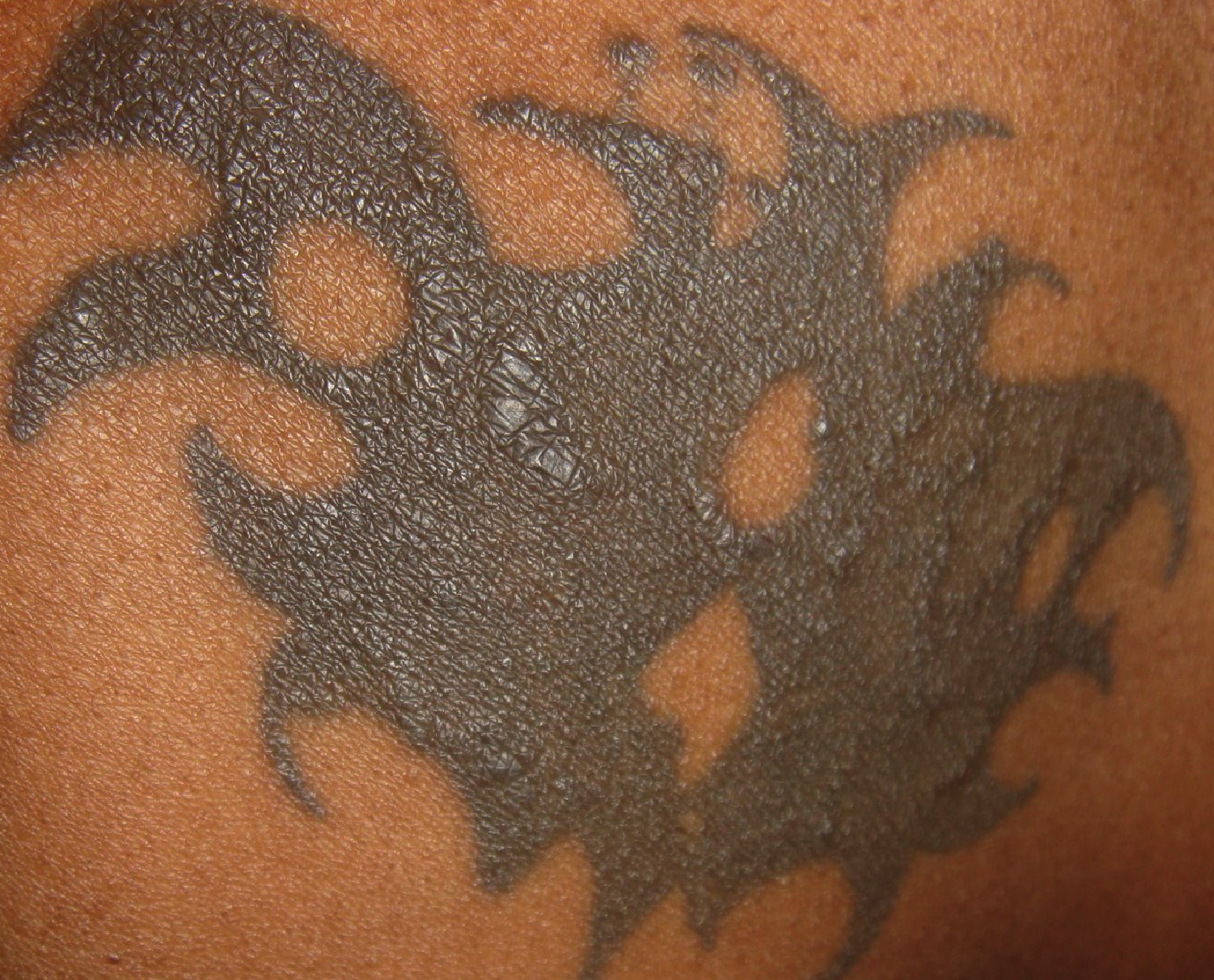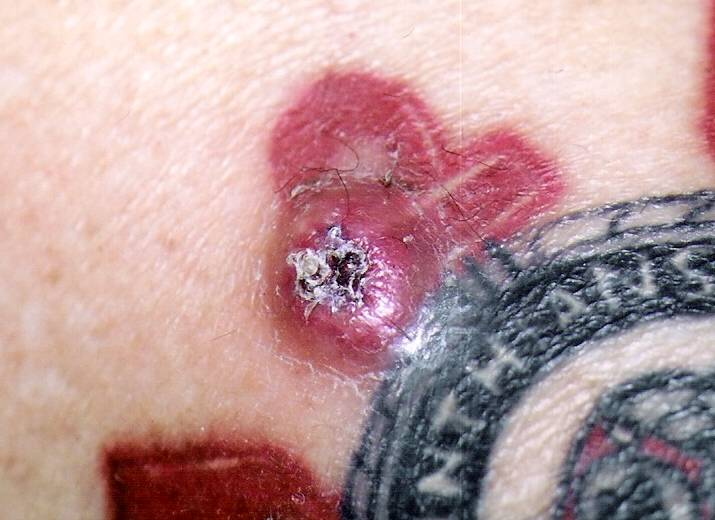[:en]
In this section, we will focus on understanding the physiology of tattoos. In this way, we will be better equipped to advise the clients on the various options to fade their tattoos. Also, this will help us understand how the fading techniques, currently available, work and how to use them in order to “remove”, or most appropriately, “fade” them effectively according to the client’s desires.

Figure 1. The Tattoo is an aesthetic drawing purposely made in order to reside permanently on the skin throughout the person’s life.
A tattoo is a skin drawing, meant to permanently be visible throughout the person's life. Tattoos historically have had various functions, mainly aesthetic and more recently they have been used for permanent make-up.
In order for the tattoo to be permanent, the ink has to be injected into the dermis, this is because the pigments that only reside on the epidermis will be removed by the natural skin regeneration process. During the skin tattooing, the ink will be deposited also on the epidermis, simply by virtue of the fact that the needle is on the way to the dermis and just passing through.
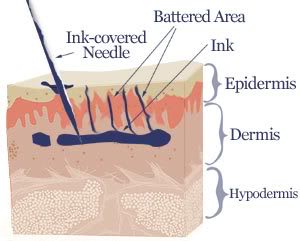
Figure 2. The tattooing process is relatively simple. It consists in injecting the tattoo pigments into the dermal layer.
As we have seen in the picture on the left, the tattooing process consists in delivering the pigments (tattoo ink) into the dermal layer. In the process of doing so both the epidermal and dermal layer will be modified and injured causing an open wound.
In the picture below we can see an example of how bright the finished tattoo work can be. This is because the pigments are also deposited onto the epidermis and most of the dermis is also exposed making the tattoo look at its brightest. When the area has healed completely, all the pigments deposited into the epidermis will have naturally been removed by the healing process. Therefore at that point, the pigments will be not present in the epidermal layer. The epidermal layer is transparent therefore the tattoo will still be clearly visible through it. However, the epidermal layer is not 100% transparent and it is slightly opaque.
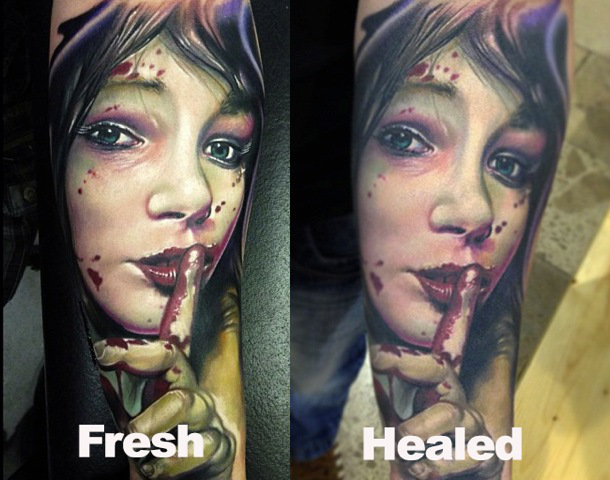
Figure 3. Once the tattoo has healed the picture loses its original brightness. This is because the tattoo is visible through the thin epidermal layer. If the epidermal layer is removed, exposing the dermal layer, the original brightness is restored.
Therefore when the tattoo has healed the original brightness is apparently lost due to the fact that it will be visible through the opaque and transparent epidermal layer.
In the picture below we can see the representative distribution of the tattoo pigments through the healing process. After the healing process, no pigmentation will be left on the epidermal layer.
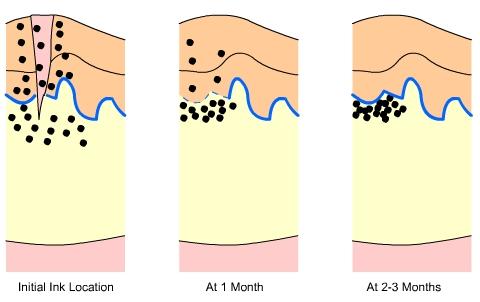
Figure 4. When the tattoo has just been made the initial ink location is both in the epidermis and the dermis, the area is essentially an open wound. Over time the scabbing process will take care of gradually removing the residual pigments form the epidermis. In a month's time, only very few residues of ink will be left on the epidermis. Once the area has healed completely the tattoo pigmentation will only reside inside the dermis and it will be visible through the epidermis.
Therefore once the tattooed area has healed the tattoo is not as bright because the pigments have completely been removed from the epidermal layer. At that point, the tattoo on the dermal layer will only be visible through the transparent epidermal layer. Conversely, the tattoo will show its full brightness once the epidermal layer has been removed. This is normally done in the tattoo removal procedures using electrical arcing.

Figure 5. In this picture, we can see where the tattoo pigments reside inside the skin once the skin has healed from the tattooing process. Although not visible from this representation, the epidermal layer is transparent, therefore allowing the tattoo to be visible.
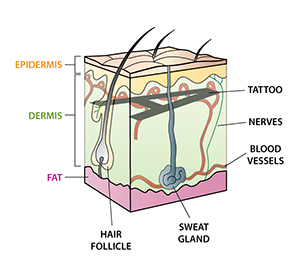
Figure 6. 3D representation of the tattoo. Once the tattoo has healed the drawing will be visible through the epidermal layer.
As we have seen because tattoos are made by injecting the pigments into the dermal layer the tattoo making process involves deliberately causing a wound to the skin. When the tattoo has just been made, the treated area is literally an open wound which is required to heal properly, in order for the tattoo work to be preserved. Because of this, the end result of the tattooing process is not only dependent on the quality work of the tattoo artist but also reliant on the after-care routine to avoid infections and other adverse side effects. The healing process will likely last anywhere from three to four weeks, and special care will be required to be taken of the recently made new body art; this is to ensure the tattoo looks its best once that healing process has finished.
A fresh tattoo is essentially an open wound, therefore it has to be treated accordingly. The main risk during the healing process of a tattoo is the likelihood of contracting an inflammatory infection of the open wound. The risk of contracting any inflammatory infection or infections in general, during the healing period, can be minimised but never completely eliminated. Infections can be contracted in several ways due to the several sources of bacteria and viruses in our everyday environment. This is because it is relatively easy for bacteria to enter the open wound of a recently drawn tattoo. The signs of a possible infection are, oozing a strange liquid, pain, redness, swelling etc. If the infection is not treated appropriately the symptoms will worsen over time and lead to several long term undesirable effects.
During the healing process, the area has to be kept infection free until the scabs have formed and fallen off by themselves.
During the healing process, the client is required to make sure the area is kept clear and free from infections. Infections can be contracted during the healing process in may ways. In order to minimise these risks, the client can simply look after the tattooed part like any other open wound, using mild antiseptics and deliberately avoid those activities which will increase the likelihood of infections.
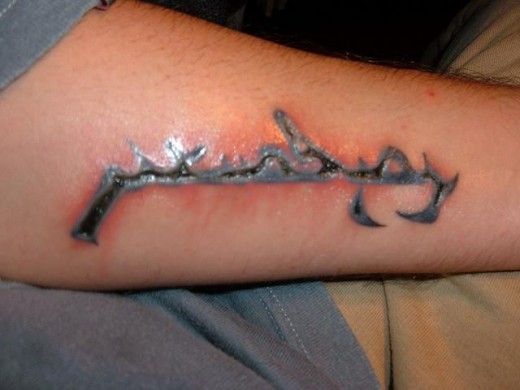
Figure 7. This in an infection at its onset. It is noticeable how the area is red at the border of the wound caused by the tattoo work. If treated immediately this types of infection may not jeopardise to the final tattoo work.
In case of tattoo infections if they are treated early on there may not be devastating consequences for the tattoo. Therefore in case, it is suspected a tattoo is becoming infected it is best to seek medical advice immediately in order to minimise the possible detrimental effects of the infection. Usually, if the infection is treated appropriately it can be cured quickly without major consequences, therefore without compromising the final tattoo work.
In the picture below we can see the devastating effects of the tattoo work which an infection can cause. An infection which is not properly looked after can lead to several undesired effects which could distort the tattoo work and even lead to fully fledged hypertrophic or atrophic permanent scars.
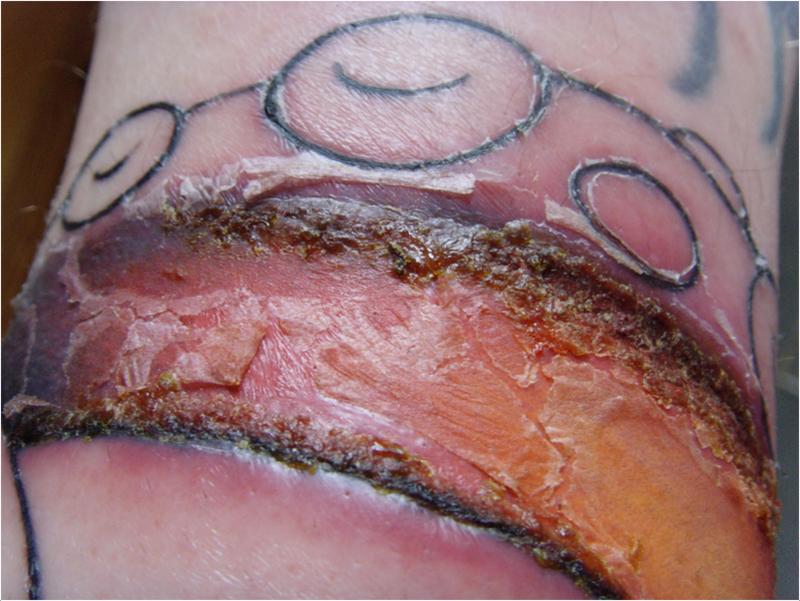
Figure 8. In this picture, we can see the dire immediate consequences of an infection caused by poor after-care after a normal tattooing procedure. This particular infection was being cured, however, it was still present at the time the picture was taken as proved by the redness of the borders of the affected area. The redness at the borders is an example of an infection induced inflammation.
Therefore if an infection is not treated promptly, effectively and with the right products the consequences could be permanent. In the above figure, the long-term effect of this type of infection can make the tattoo distorted and also lead to scarring.
Here are the most common symptoms of an infected tattoo. If your client is experiencing any of these, it is time to take action. Remember, if you are in doubt whether an infection is ongoing it is always advisable to consult a physician because General Practitioners are legally qualified to diagnose an infection and prescribe the medical treatment of each specific case. The tattoo artist, although will recognise an infected tattoo immediately, due to his vast experience, he may not be qualified to make a diagnosis and advise on the best medical treatment of each specific case. Legislation may vary from country to country.
- Redness. The area starts to redden and the redness may include the tattoo work itself and the edges too. The redness of the edges feathers out and it spreads further as the infection worsen over time if not treated properly.
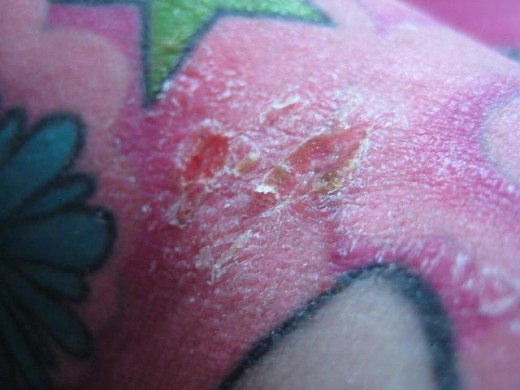
Figure 9. Redness can be a symptom of an inflammatory infection. We can see how the inflamed area peels off.
- Swelling. It is normal for a tattoo to swell during the first 48 hours after the tattoo as being drawn, however, if the swelling increases over three to four days instead of decreasing, or begins to extend past the tattoo a fair distance, this is likely a sign of infection.
- Heat. An infected tattoo might feel hot to the touch. While it is normal for the tattoo to feel warm, especially during the first 48 hours, it should not feel very hot and the heat should fade away on its own accord. If it is infected, the whole tattoo and/or the area around it may feel hot to the touch, and if may also feel as if there is heat radiating from within the tattoo itself.
- Discharge. During the first 48 hours after the tattoo has just been drawn a slights discharge and some bleeding can occur and this is normal. However, if this continues or worsens after the first 48 hours it can be a clear sign of infection. The infected tattoo often has a slimy discharge oozing from them in various places; this may appear as a clear fluid with a golden colour or a thick yellow-green goo that sits within the tattoo. You might also see pus (white, yellow, or green).
- Odour. This a sure-fire sign that your tattoo is infected. Often the discharge from an infected tattoo will have a nasty smell or odour. The smell increases in intensity as the infection spreads or worsen.
- Pain. If you're experiencing mild or extreme pain that increases over the 3-5 days after your tattoo or has sharp, shooting pains from within the tattoo itself, it is likely an infection.
- Blistering. Blistering may also be a sign of infection, and it can occur on top of the tattoo, manifesting as red, raised sores filled with body fluids. If your tattoo is bubbly or bright red, then this is a sign of infection. This is not to be confused with the normal swelling occurring after the first 48 hours of receiving your tattoo, any raised areas should slowly level out and decrease to the height of the surrounding (non-tattooed) skin.
- Increased scab size. Due to abnormal levels of discharge, the scabs on an infected tattoo may appear thick and bulbous and have a yellow and green crust. This normally occurs when the infections are subsiding while the scabs are being formed. This is generally a better situation than the symptoms mentioned above.
- Fever and lethargy. This is possible in advanced stages of infection, also this can occur if the tattoo is relatively large and infected. An infection over a large area will trigger the natural feverish body reaction, which is designed to help the body combat bacterial infections. If you have a fever or feel lethargic and these symptoms are unrelated to other illnesses, then it's likely your body is working overtime to fight the infection coming from your tattoo. If you experience any of the symptoms above, fever is one of the surest signs of infection, even if your temperature is only slightly elevated. In fact, even a slight elevated temperature can be symptomatic of serious advanced state of a inflammatory skin infection. Skin infections rarely lead to high temperature fevers.
- Redness or streaking. This is an extremely severe case of an advanced stage of infection. As we have seen previously, if the tattoo or the skin around it is extremely red, you likely have an infection. If you see thin red lines radiating from your tattoo, you should go to the doctor immediately as streaking can be an early sign of blood poisoning.
As we have seen above, the tattoo is an open wound when it is just been drawn. The tattooing is a process which can last several weeks to reach its final permanent appearance.Understanding the healing stages of tattoos provides a better idea of what to expect in the days and weeks to come after the tattoo has been just made. The end result depends on the after-care and not only on the final tattoo work at the time it was drawn. In the video below you can have a quick overview of the tattoo healing process.
The tattoo healing process can be divided into three main stages:
- Stage one, healing the open wound. Most delicate part of the process, this is when an infection or diseases can be contracted through the open wound.
- Stage two, scabbing or peeling process.
- Stage three, pigments resettling.
Overall, the healing stages of tattoos stretch out over a three to four week period up to two to three months, and taking special care of the tattoo during this time is essential to preserve the wonderful work the tattoo artist has created. If you experience any symptoms beyond those mentioned here, contact your doctor (for medical advice) and tattoo artist straight away. Although your tattoo artist cannot provide medical advice, tattoo artists are very familiar with the signs of abnormal healing and the signs of a burgeoning infection. Remember that if in doubt you should always consult your doctor.
This initial stage of healing begins right after your tattoo is finished. At this point, you can consider the area, for what it is, an open wound, and it should be treated accordingly. Your artist will gently wash the area and bandage it to protect it from bacteria. Most artists recommend you keep the area covered for the first twenty-hours, although you will likely need to change the bandage because a fresh tattoo usually bleeds and can weep slightly. All fresh tattoos are temporarily covered bandaged to help prevent infection. This healing stage usually last about one week. If the bandage soak up too much fluid, it may wind up sticking to the newly tattooed skin, and this is definitely not good for the healing process.
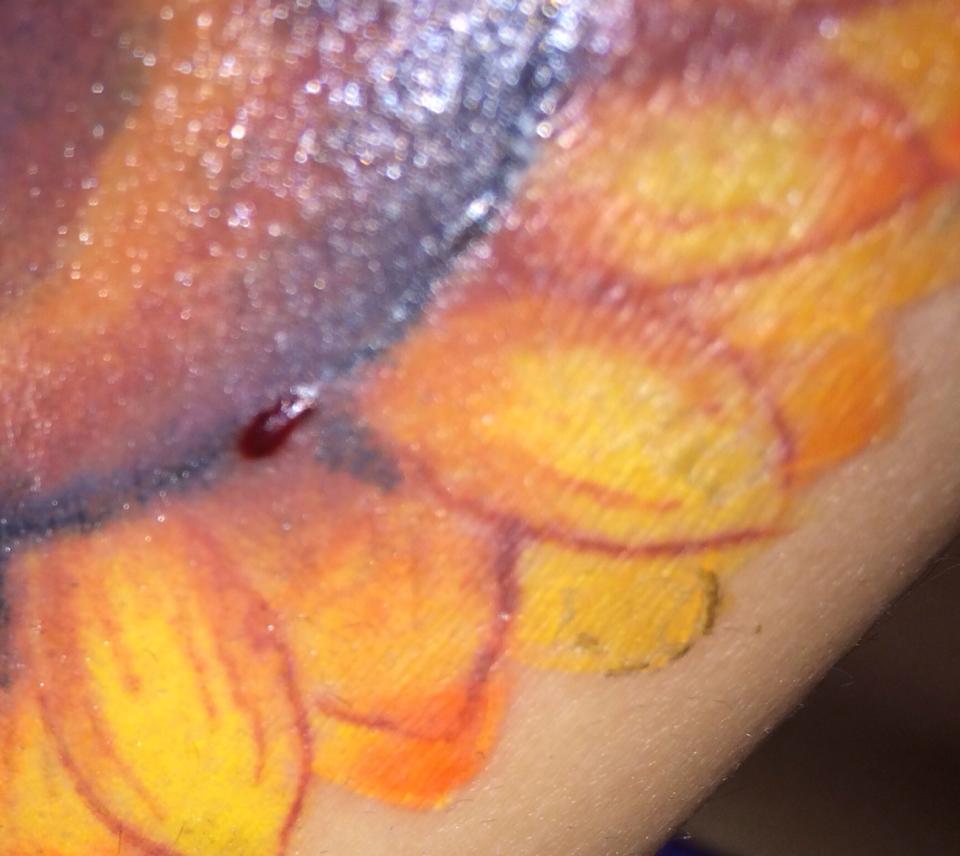
Figure 12. Fresh tattoos can bleed and weep like any other open wound which requires healing. In this picture, we can see a fresh tattoo slightly bleeding and weeping.
Many people describe a fresh tattoo as feeling similar to a sunburn. The area tends to sting, and it can become inflamed, a little raised and/or swollen. This is all a natural and normal reaction to the tattoo healing process.
As we have seen the tattoo is an open wound caused by the injury inflicted by the tattooing procedure, and after any inflicted skin injury the skin can become inflamed and swell. This is, in fact, a normal reaction to being expected in the normal tattooing process.
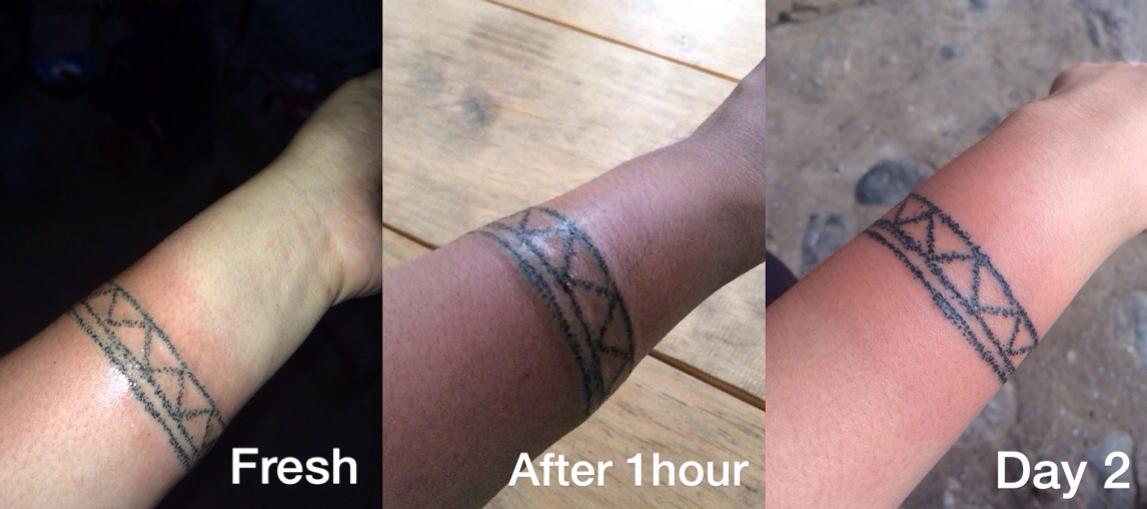
Figure 13. This picture serves to show the immediate effects of the tattooing process. Tattooing involves not only deliberately causing a wound inside the dermis, but also impregnating the dermis with the ink necessary to make the drawing requested by the client. Sometimes swelling can be caused by both the injury caused by the tattooing needle and the dermis reaction to the new substance injected into the dermis.
Inflammation and swelling are to be expected because the tattooing process deliberately inflicts a wound (injury) into the dermis therefore they are a normal skin reaction which often occurs soon after the tattooing. It normally begins immediately after the area has been tattooed, it lasts up to one to two days and it subsides on its own accord. Additionally, in certain cases, the swelling can be exacerbated by the individual skin reaction to the new external agent injected into the dermis (the tattoo ink colour/s). The swelling will subside on its own accord and normally two days after the treatment it will have subsided. If the swelling does not subside, this can be a clear sign of infection or some other side effect which will likely require medical attention.
Scabs will begin to form over the tattooed area a four to five days after the tattoo had been first made. No attempt must be made to remove them, any scabs must not be picked and should fall off by themselves. Just gently wash the area once or twice a day with a very mild soap, pat dry with a fresh paper towel. Gently dab on a light amount of the moisturising after-care lotion only if your tattoo artist recommends it.
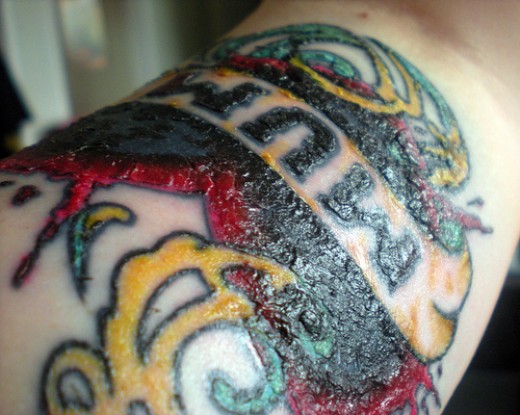
Figure 14. The fresh tattoo is an open wound that requires healing. The scabbing process usually sets on the third or fourth day after the tattoo has been drawn, provided that the area has not become infected. During this period avoid the use of any product not expressedly recommended by your tattoo artist as using unsuitable products on an open wound can cause unnecessary complications.
Do not apply any creams or product on the fresh tattoo other than those expressedly recommended by the tattoo artist as applying unsuitable products on an open wound, could easily lead to unnecessary complications. After all, a fresh tattoo is an open wound which is trying to heal by its own accord.
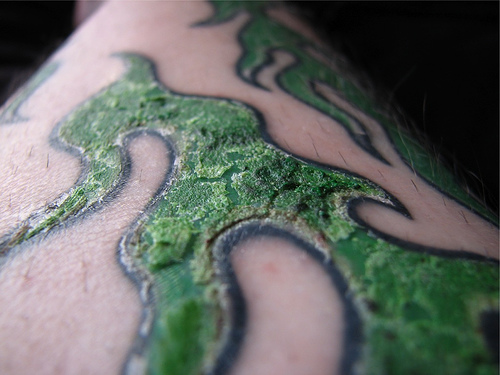
Figure 15. The scabbing also contain some of the pigments injected during the tattoo drawing as demonstrated by this green scabbing.
Although people tend to heal at different rates, the first healing stage of a tattoo usually lasts about one week as long as an infection doesn't set in. Some people can experience some discomfort and even pain, in those cases the pain is more than expected, some over-the-counter pain reliever can be taken. In any case, if in doubt you can visit your doctor.
The second stage of healing usually brings the onset of scabbing, peeling and itching. After the first healing stage, the scabs are well formed and just beginning to flake off. This process will continue for about a week. The skin around the tattoo may become a bit dry. Most people experience some peeling, just as they would with a sunburn.

Figure 16. Peeling effect of a tattoo after the scabbing has taken place. This process normally lasts for a week.
The client has to avoid both picking the scabs and peeling the flaky skin intentionally, doing so can jeopardise the final tattoo results. Just allow it to slough off naturally and, by all means, do not scratch your tattoo. Scratching can cause damage and ultimately spoil the look of the tattoo work by the time healing is complete. Applying more after-care lotion to the area should bring some relief to the itching, however, please note that the itching is a natural reaction of the skin to the good healing of any skin injury (including tattooing).
Stage three brings the final healing of the area. By this point, most or all of the scabs have fallen away from the tattoo, although the area may still be slightly dry and mildly tender. At that point, some mild itchy feeling can be still felt and the tattoo does not look as vibrant as it did when it was first finished, and this is normal. There is typically still a layer of dead skin over the tattoo at this point that obscures it a bit, but once that layer naturally and slowly sloughs away the tattoo will look as it should see what your new tattoo really looks like. If you have managed to avoid infection and scratching, it probably looks great.
In any case, please follow the recommendations of your own tattoo artist. If you require any medical advice consult your doctor. The after-care has to be performed by the client and consequently, the client alone assumes all responsibilities to carry it out appropriately.
Always wash your hands before touching your tattoo especially while the tattoo is still an open wound (stage one)! When you get home: Remove bandage within 2-3 hours after getting your tattoo. Re-bandage according to the instructions of your tattoo artist. On the first night, you may want to wrap your tattoo in saran wrap to prevent sticking to your bedding. Do not use any cloth bandages or pads, as the fibres of this material can adhere to your open tattoo and hinder the healing process. Wash your tattoo with an anti-bacterial liquid soap, use only the one suggested by your tattoo artist. Be gentle, do not use a wash cloth or anything that will ex-foliate your tattoo. Gently pat your tattoo dry with a clean cloth or paper towel. Do not rub, and do not use a fabric with a rough surface.
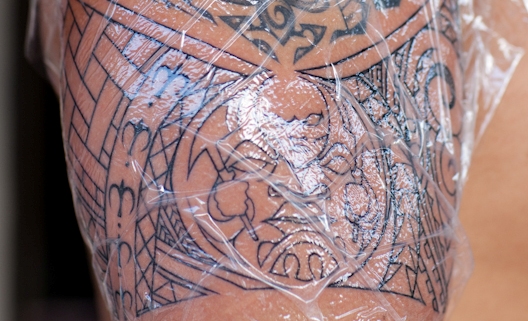
Figure 17. Tattoo wrapped in cling film for protection. This is usually done the first night after the tattoo is done to prevent contact with the bedding. Keeping the tattoo wrapped in cling film for too long d is detrimental as it creates the moist conditions for bacterial proliferation and hence infection. However, it has been found that during the first-night sleep the bandaging of the tattoo in cling film is more beneficial than detrimental.
The first 3-4 days: Apply a small amount of ointment on your tattoo as recommended by your tattoo artist. Please do not use antibiotic ointments as a means of preventing infections (this is because doing do will eventually induce a bacterial resistance to the specific antibiotic substance). Use a suitable antiseptic cream or ointment instead.
Always use clean hands and do not place your fingers back into the antiseptic ointment (or cream) after touching your tattoo. Preferably you should use a clean ear bud (or similar) to place the ointment from the tab onto the tattoo, this is to minimise bacterial contamination of the ointment you are using. Make sure to rub the ointment in so that it is not shiny, or greasy– you want the thinnest amount possible. Pat off any excess ointment with a clean cloth or paper towel.
Do not use petroleum jelly (Vaseline), or Bag Balm. Wash, dry and apply ointment 3-5 times daily, as needed.
Wear clean, soft clothing over your tattoo for the first 2 weeks– do not use any tight clothing, nothing abrasive or irritating (i.e. wool). For a foot tattoo: go barefoot as long as possible. If you must wear shoes, first wrap your clean tattoo in saran wrap, then cover with a clean cotton sock before putting on your shoe. Avoid sandals or flip flops for this period to prevent chafing and damage to the tattoo.
After day 4 to 5: Your tattoo should begin to scab. This is normal and a good sign! Do not pick at the scabs. Begin using a mild, white, unscented lotion, free of dyes or Perfumes. Use lotion for minimum 2 weeks, 1-2 times daily.
- Do not apply any product not explicitly recommended by your tattoo artist as doing so especially during the healing phase (stage one) of the healing process could seriously jeopardise the tattoo work.
- Do not apply petroleum based skin products to your tattoo.
- You can shower, but you may not soak your tattoo for 2 weeks. No swimming, soaking or hot tub.Avoid swimming. In the swimming pool, Chlorine can leach colour and dry out the still tender skin around your tattoo. In the sea, the salty water could have undesirable effects on your tattooed area. Not hot tub.
- Do not wear tight, abrasive materials, jewellery, or shoes that rub against your tattoo.
- Do not let anyone touch your tattoo unless they wash their hands.
- Don't soak in the tub. This can allow bacteria to penetrate the unhealed needle wounds.
- Avoid exposing your new tattoo to direct sunlight. This can lead to fading and you could easily burn the unhealed skin.
- Do not pick at your scabs or scratch/rub your tattoo.
- Beware of gym equipment, wash it well before using it.
Even if the tattoo has been drawn correctly, using the best equipment available and the best possible quality pigmentation certain undesirable effects can still occur. They can be minimised but never eliminated altogether.
This is a side effect which is directly dependent on the type of pigmentation used during the tattooing procedure. The best quality pigments should not lead to an increased risk of cancer throughout life.
Studies to document the effect of tattoos on the body and its relationship with cancer are still ongoing however several experts are of the opinion that tattoos can increase the likelihood of developing cancer later in life depending on the type of substances used in the pigments. Where earlier tattoos were made from natural dyes, today’s inks can be made from a variety of ingredients such as pigments suspended in a carrier solution for colour, of which the pigments are composed of plastics or metallic salts such as mercury sulfide, cobalt albuminate, cadmium, chromium and chromic oxides. It is also claimed that the nano particles from the tattoo ink can seep into the body’s major organs, apart from permanent damage caused by the dyes to collagen.
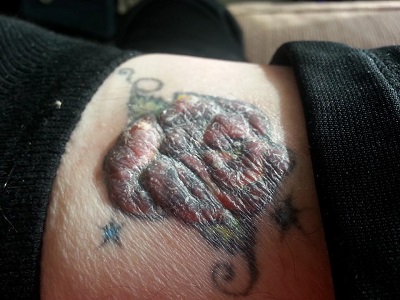
Figure 18. Abnormal growth inside a tattoo. Cancer scares are associated with the body reacts to certain substances in the tattoo pigments.
Aluminium silicates and Barium sulphates are used to preserve some physical properties of the tattoo and ferrous oxides and titanium oxides are mixed as well for desired transparency. The toxicity of the inks, whose chemical composition is sometimes unknown and mostly unregulated, can travel through the bloodstream to accrue in the kidneys and the spleen. The most common health risk that you put yourself into when you get a tattoo would always be – skin cancer. Though not proven, tattoos do raise the risk of developing melanomas that is abnormal growth of cells.
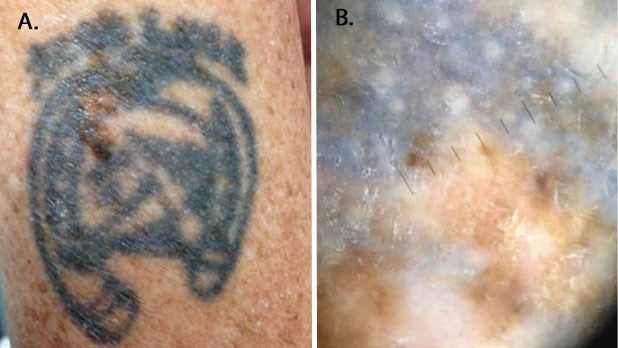
Figure 19. Melanoma developing inside a tattoo. Sometimes these malignant growths are concealed inside the tattoo making their correct diagnosis more challenging. A direct correlation between melanoma and tattooing has not been proved to this date.
Now the actual amount and mixture of these constituents vary from parlour to parlour because it is considered a trade secret. These inks are injected below the skin layer for permanency and the toxic effect of these metals in your body is however in small amounts, but cannot be ignored. From growth retardation, mild irritants, pulmonary effects to affecting the cardiovascular systems, these can all be the side effects of just getting a tattoo.

Figure 20. Remember to choose the reputable tattoo parlours and guard the fresh tattoo against infections during the first stage of the healing period.
This is an effect merely attributable to the specific safety standards of the tattoo parlour you are using to get your tattoo done. The use of non-sterile needles during the process of tattoo application can increase the risks of contracting transfusion-transmitted diseases such as tetanus, hepatitis B and C, herpes, tetanus, staph, syphilis and HIV due to simple needles "cross-contamination". Hence there are several places where prospective blood donors are screened for tattoos. Therefore it is important that you visit an established and well-known shop which follows proper safety standards to prevent the spread of these diseases. New, sealed needles for every new tattoo, sterilizing hands and instruments regularly and using gloves are basic safety protocols every tattoo parlour is required to follow.
Remember that while the tattoo is still an open wound (stage 1) although the tattoo work has been carried out in sterile conditions and there was no cross contamination you can still acquire most of the diseases mentioned above through contact of the open wound with the respective viruses and/or bacteria.
People prone to developing Keloids should avoid undergoing any form of tattooing. Scars are bound to occur during the initial healing phase of the tattooing (stage one) if the proper care steps are not followed properly or inflammatory infections develop.
Keloids are a type of collagen overgrowth tissue formed at the site of a wound. They are firm and rubbery and pink to purplish in colour. In contrast to scars, keloids do not diminish with time and continue to grow. They can grow beyond the boundaries of the wounds which caused them; certain people are more prone to developing them than others depending on family history, hence they should avoid getting piercings or tattoos done.
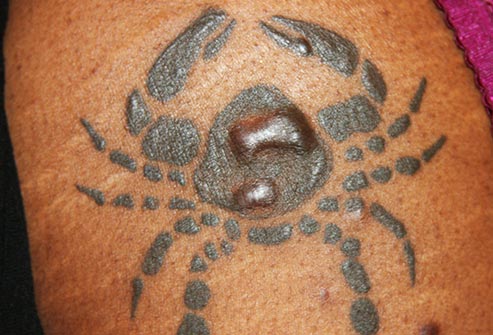
Figure 21. Keloidal formation caused by a simple tattooing. Every client should be warned in advance of the likelihood of developing Keloids before carrying out any tattooing.
By getting a tattoo done people with past Keloidal history, put themselves at risk of growing new Keloids due to the injury inflicted by the tattooing process itself. Keloids can develop irrespective of the way the tattoos have been drawn and the after-care carried out during the healing phase. To know more about Keloids please click here.
Allergic Reactions to tattoos are quite common and there are different types of allergies that can be caused. Most often it is advisable to perform a patch test to determine whether your skin is too sensitive for the tattoo inks prior to actually getting it, but it may not always be a sure way of knowing. The main issue in order to prevent allergic reactions to tattoos is that, even if all ingredients are stated in the pigments packaging used, no one is always aware of all his/her possible reactions to each specific agent used in the tattoo colours or their mixture.
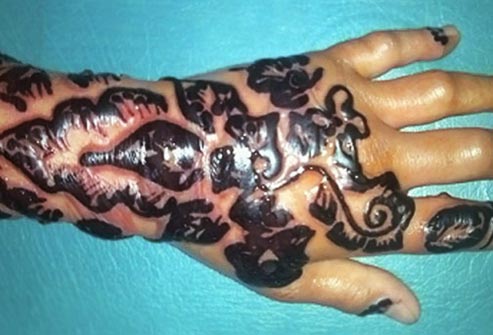
Figure 22. Example of an allergic reaction to the tattoo pigments. Swelling occurs in the tattooed areas only.
Allergic reactions have occurred with some of the many metals put into tattoo inks, nickel is one of the most common metal allergies. Others have reacted to the mercury in red cinnabar, to cobalt blue, and to cadmium sulfite when used as a yellow pigment. Some inks were found to have high levels of lead, some contained lithium, and the blue inks were full of copper. The long-term health effects of sustained allergic reactions to tattoos are still unknown due to the lack of regulation, testing, and long-term studies
Phototoxic reactions do occur, though not very common, considering the number of people who get tattoos done every year, where phototoxicity means having a reaction on exposure to sunlight. Inflammatory reactions caused primarily by the inks appear as swellings and red rashes which generally occurs for everyone and is expected to disappear within 2 to 4 weeks with proper attention and care.
Dermatitis caused due to allergic reactions to pigments is characterized by inflamed skin rashes and by the affected area becoming scaly or flaky. These allergic reactions do not always occur immediately after the tattoo has been applied, sometimes the effects can be delayed by months, even years. Itchiness and red bumps which can be caused due to changes in weather or body temperature often occur which will probably require a visit to your dermatologist or antibiotics.
Granulomas is a collection of immune cells known as histiocytes. Granulomas form when the immune system attempts to wall off substances it perceives as foreign but is unable to eliminate. Since tattoo ink particles are foreign material, granulomas can develop around or inside the tattooed tissue. Apart from granulomas, enlargement of the lymph nodes have also been reported as a side effect of tattoos. The pigments used, leak into the bloodstream, accumulating at the lymph nodes causing painful swellings in these regions. The major cause of concern due to these inflammations is the misdiagnosis of melanoma. In patients with cancer risks, a Radiologist is often unable to distinguish between the ink staining in the lymph node and the abnormal tissue growth.
Other side effects of tattooing maybe:
- Haematomas are bruises that can occur due to the puncturing of a blood vessel during the tattooing process and can occur as blood pools.
- Keratoacanthoma is a skin tumour characterized by a dome-shaped inflamed skin which gradually increases in size and its developments risks increase with tattoos.
- Hyperkeratosis which is an excess growth of keratin in hair follicles are all examples of abnormal growth whose occurrence also will depend from person to person and also the tattoo artist.
- Hyperplasia can also occur, hyperplasia is an organ enlargement due to abnormal cell multiplication.
Since the inks used for tattooing contain metals, there have been complaints by people having tattoos, to experience a burning sensation, when they are undergoing an MRI scan. Though not conclusively verified, there have been reports of the MRI image’s quality getting affected by the pigments in the tattoo inks. An MRI or a magnetic resonance imaging creates pictures of the interior of the body using magnetic fields and radio frequency pulses. The concern for tattoo inks arises mainly due to the magnetic force which is extremely powerful and can affect the metal particles in the inks. Hence the MRI s done for people with tattoos requires more attention.
[:es]
En esta sección, nos centraremos en la comprensión de la fisiología de los tatuajes. De esta manera, estaremos mejor equipados para asesorar a los clientes sobre las diversas opciones para desvanecer sus tatuajes. Además, esto nos ayudará a comprender cómo funcionan las técnicas de desvanecimiento, actualmente disponibles, y cómo usarlas para “eliminar”, o más adecuadamente, “desvanecerlas” de manera efectiva según los deseos del cliente.

Figura 1. El tatuaje es un dibujo estético hecho a propósito para residir permanentemente en la piel a lo largo de la vida de la persona.
Un tatuaje es un dibujo de la piel, destinado a ser visible permanentemente a lo largo de la vida de la persona. Los tatuajes han tenido históricamente varias funciones, principalmente estéticas y, más recientemente, se han utilizado para el maquillaje permanente.
Para que el tatuaje sea permanente, la tinta debe inyectarse en la dermis, esto se debe a que los pigmentos que solo residen en la epidermis se eliminarán mediante el proceso natural de regeneración de la piel. Durante el tatuaje de la piel, la tinta se depositará también en la epidermis, simplemente en virtud del hecho de que la aguja está en camino a la dermis y solo pasa a través de ella.

Figura 2. El proceso de tatuaje es relativamente simple. Consiste en inyectar los pigmentos del tatuaje en la capa dérmica.
Como hemos visto en la imagen de la izquierda, el proceso de tatuaje consiste en entregar los pigmentos (tinta de tatuaje) en la capa dérmica. En el proceso de hacerlo, tanto la capa epidérmica como la dérmica serán modificadas y lesionadas causando una herida abierta.
En la siguiente imagen podemos ver un ejemplo de lo brillante que puede ser el trabajo de tatuaje terminado. Esto se debe a que los pigmentos también se depositan en la epidermis y la mayor parte de la dermis también está expuesta, lo que hace que el tatuaje se vea más brillante. Cuando el área se haya curado completamente, todos los pigmentos depositados en la epidermis se habrán eliminado de forma natural mediante el proceso de curación. Por lo tanto, en ese punto, los pigmentos no estarán presentes en la capa epidérmica. La capa epidérmica es transparente, por lo que el tatuaje aún será claramente visible a través de ella. Sin embargo, la capa epidérmica no es 100% transparente y es ligeramente opaca.

Figura 3. Una vez que el tatuaje se ha curado, la imagen pierde su brillo original. Esto se debe a que el tatuaje es visible a través de la delgada capa epidérmica. Si se elimina la capa epidérmica, exponiendo la capa dérmica, se restaura el brillo original.
Por lo tanto, cuando el tatuaje se ha curado, el brillo original se pierde aparentemente debido al hecho de que será visible a través de la capa epidérmica opaca y transparente.
En la siguiente imagen podemos ver la distribución representativa de los pigmentos del tatuaje a través del proceso de curación. Después del proceso de curación, no quedará pigmentación en la capa epidérmica.

Figura 4. Cuando se acaba de hacer el tatuaje, la ubicación inicial de la tinta está tanto en la epidermis como en la dermis, el área es esencialmente una herida abierta. A lo largo del tiempo, el proceso de raspadura se encargará de eliminar gradualmente los pigmentos residuales de la epidermis. En un mes, solo quedarán muy pocos residuos de tinta en la epidermis. Una vez que el área se haya curado completamente, la pigmentación del tatuaje solo residirá dentro de la dermis y será visible a través de la epidermis.
Por lo tanto, una vez que el área tatuada ha cicatrizado, el tatuaje no es tan brillante porque los pigmentos se han eliminado completamente de la capa epidérmica. En ese momento, el tatuaje en la capa dérmica solo será visible a través de la capa epidérmica transparente. A la inversa, el tatuaje mostrará su brillo total una vez que se haya eliminado la capa epidérmica. Esto normalmente se hace en los procedimientos de eliminación de tatuajes utilizando arcos eléctricos.

Figura 5. En esta imagen, podemos ver dónde residen los pigmentos del tatuaje dentro de la piel una vez que la piel se ha curado del proceso de tatuaje. Aunque no es visible desde esta representación, la capa epidérmica es transparente, lo que permite que el tatuaje sea visible.

Figura 6. Representación 3D del tatuaje. Una vez que el tatuaje se haya curado, el dibujo será visible a través de la capa epidérmica.
Como hemos visto, porque los tatuajes se hacen inyectando los pigmentos en la capa dérmica, el proceso de creación del tatuaje consiste en causar deliberadamente una herida en la piel. Cuando se acaba de hacer el tatuaje, el área tratada es, literalmente, una herida abierta que se requiere para curarse adecuadamente, a fin de preservar el trabajo del tatuaje. Debido a esto, el resultado final del proceso de tatuaje no solo depende de la calidad del trabajo del artista del tatuaje, sino que también depende de la rutina de cuidado posterior para evitar infecciones y otros efectos secundarios adversos. El proceso de curación probablemente durará de tres a cuatro semanas, y se requerirá un cuidado especial para el nuevo arte corporal recientemente creado; esto es para asegurar que el tatuaje se vea mejor una vez que el proceso de curación haya terminado.
Un tatuaje nuevo es esencialmente una herida abierta, por lo tanto, debe tratarse en consecuencia. El principal riesgo durante el proceso de curación de un tatuaje es la posibilidad de contraer una infección inflamatoria de la herida abierta. El riesgo de contraer cualquier infección inflamatoria o infecciones en general, durante el período de curación, puede minimizarse pero nunca eliminarse por completo. Las infecciones se pueden contraer de varias maneras debido a las diversas fuentes de bacterias y virus en nuestro entorno cotidiano. Esto se debe a que es relativamente fácil para las bacterias ingresar a la herida abierta de un tatuaje recientemente dibujado. Los signos de una posible infección son: rezuma un líquido extraño, dolor, enrojecimiento, hinchazón, etc. Si la infección no se trata adecuadamente, los síntomas empeorarán con el tiempo y provocarán varios efectos adversos a largo plazo.
Durante el proceso de curación, el área debe mantenerse libre de infecciones hasta que las costras se formen y se caigan por sí mismas.
Durante el proceso de curación, el cliente debe asegurarse de que el área se mantenga limpia y libre de infecciones. Las infecciones pueden contraerse durante el proceso de curación de muchas maneras. Para minimizar estos riesgos, el cliente puede simplemente cuidar la parte tatuada como cualquier otra herida abierta, usar antisépticos suaves y evitar deliberadamente aquellas actividades que aumentarán la probabilidad de infecciones.

Figura 7. Esto en una infección en su inicio. Es notable cómo el área es roja en el borde de la herida causada por el trabajo del tatuaje. Si se trata de inmediato, este tipo de infección puede no comprometer el trabajo final del tatuaje.
En el caso de las infecciones por tatuajes, si se tratan temprano, puede que no haya consecuencias devastadoras para el tatuaje. Por lo tanto, en caso de que se sospeche que un tatuaje se está infectando, es mejor buscar consejo médico de inmediato para minimizar los posibles efectos perjudiciales de la infección. Por lo general, si la infección se trata adecuadamente, se puede curar rápidamente sin mayores consecuencias, por lo tanto, sin comprometer el trabajo final del tatuaje.
En la siguiente imagen podemos ver los efectos devastadores del trabajo de tatuaje que puede causar una infección. Una infección que no se cuida adecuadamente puede provocar varios efectos no deseados que podrían distorsionar el trabajo del tatuaje e incluso provocar cicatrices permanentes atrofiadas o hipertróficas de pleno derecho.

Figura 8. En esta imagen, podemos ver las consecuencias inmediatas y terribles de una infección causada por un cuidado deficiente después de un procedimiento de tatuaje normal. Esta infección en particular se estaba curando, sin embargo, todavía estaba presente en el momento en que se tomó la fotografía, como lo demuestra el enrojecimiento de los bordes del área afectada. El enrojecimiento en los bordes es un ejemplo de una inflamación inducida por una infección.
Por lo tanto, si una infección no se trata de manera rápida, efectiva y con los productos adecuados, las consecuencias podrían ser permanentes. En la figura anterior, el efecto a largo plazo de este tipo de infección puede distorsionar el tatuaje y provocar cicatrices..
Aquí están los síntomas más comunes de un tatuaje infectado. Si su cliente está experimentando alguno de estos, es hora de actuar. Recuerde, si tiene dudas sobre si una infección está en curso, siempre es recomendable consultar a un médico porque los médicos generales están legalmente calificados para diagnosticar una infección y prescribir el tratamiento médico de cada caso específico. El artista del tatuaje, aunque reconocerá un tatuaje infectado de inmediato, debido a su vasta experiencia, puede que no esté calificado para hacer un diagnóstico y asesorar sobre el mejor tratamiento médico de cada caso específico. La legislación puede variar de un país a otro.
- Enrojecimiento. El área comienza a enrojecerse y el enrojecimiento puede incluir el trabajo del tatuaje y los bordes también. El enrojecimiento de los bordes se difumina y se propaga a medida que la infección empeora con el tiempo si no se trata adecuadamente. tatuaje de infección temprana

Figura 9. El enrojecimiento puede ser un síntoma de una infección inflamatoria. Podemos ver cómo la zona inflamada se despega.
- Hinchazón.Es normal que un tatuaje se hinche durante las primeras 48 horas después de que el tatuaje se dibuje, sin embargo, si la hinchazón aumenta de tres a cuatro días en lugar de disminuir, o comienza a extenderse más allá del tatuaje una distancia considerable, es probable Signo de infección.
- Calor. Un tatuaje infectado puede sentirse caliente al tacto. Si bien es normal que el tatuaje se sienta cálido, especialmente durante las primeras 48 horas, no debe sentirse muy caliente y el calor debe desaparecer por sí solo. Si está infectado, todo el tatuaje y / o el área que lo rodea pueden sentirse calientes al tacto, y también se puede sentir como si hubiera calor irradiado desde el interior del tatuaje.
- Secreción. Durante las primeras 48 horas después de que se acaba de dibujar el tatuaje, se producen derrames leves y se puede producir un sangrado y esto es normal. Sin embargo, si esto continúa o empeora después de las primeras 48 horas, puede ser un signo claro de infección. El tatuaje infectado a menudo tiene un flujo viscoso que rezuma en varios lugares; Esto puede aparecer como un líquido transparente con un color dorado o una sustancia pegajosa espesa de color amarillo verdoso que se encuentra dentro del tatuaje. También puede ver pus (blanco, amarillo o verde).
- Olor. Este es un signo seguro de que su tatuaje está infectado. A menudo, la secreción de un tatuaje infectado tendrá un olor desagradable. El olor aumenta en intensidad a medida que la infección se propaga o empeora.
- Dolor Si experimenta un dolor leve o extremo que aumenta de 3 a 5 días después de su tatuaje o tiene dolores agudos y punzantes dentro del tatuaje, es probable que se trate de una infección.
- Ampollas. La formación de ampollas también puede ser un signo de infección, y puede aparecer en la parte superior del tatuaje, que se manifiesta como una úlcera roja llena de líquidos corporales. Si su tatuaje es burbujeante o rojo brillante, entonces esto es un signo de infección. Esto no debe confundirse con la hinchazón normal que se produce después de las primeras 48 horas de recibir su tatuaje, las áreas elevadas deben nivelarse lentamente y disminuir a la altura de la piel circundante (no tatuada).
- Aumento del tamaño de la costra. Debido a los niveles anormales de secreción, las costras en un tatuaje infectado pueden parecer gruesas y bulbosas y tener una corteza amarilla y verde. Esto ocurre normalmente cuando las infecciones disminuyen mientras se forman las costras. Esta es generalmente una situación mejor que los síntomas mencionados anteriormente.
- Fiebre y letargo. Esto es posible en etapas avanzadas de infección, y esto también puede ocurrir si el tatuaje es relativamente grande e infectado. Una infección en un área grande desencadenará la reacción natural de fiebre del cuerpo, que está diseñada para ayudar al cuerpo a combatir las infecciones bacterianas. Si tiene fiebre o se siente letárgico y estos síntomas no están relacionados con otras enfermedades, entonces es probable que su cuerpo trabaje horas extras para combatir la infección que proviene de su tatuaje. Si experimenta alguno de los síntomas anteriores, la fiebre es uno de los signos más seguros de infección, incluso si su temperatura está solo ligeramente elevada. De hecho, incluso una ligera temperatura elevada puede ser un síntoma de un estado avanzado grave de una infección inflamatoria de la piel. Las infecciones de la piel rara vez conducen a fiebre alta.
- Enrojecimiento o rayas. Este es un caso extremadamente grave de una etapa avanzada de infección. Como hemos visto anteriormente, si el tatuaje o la piel que lo rodea es extremadamente rojo, es probable que tenga una infección. Si ve líneas delgadas rojas que irradian de su tatuaje, debe acudir al médico de inmediato, ya que las rayas pueden ser un signo temprano de envenenamiento de la sangre.
Como hemos visto anteriormente, el tatuaje es una herida abierta cuando se acaba de dibujar. El tatuaje es un proceso que puede durar varias semanas para alcanzar su apariencia definitiva. La comprensión de las etapas de cicatrización de los tatuajes proporciona una mejor idea de qué esperar en los próximos días y semanas después de que se haya hecho el tatuaje. El resultado final depende de la atención posterior y no solo del trabajo de tatuaje final en el momento en que se realizó. En el video a continuación, puede tener una visión general rápida del proceso de curación del tatuaje.
El proceso de curación del tatuaje se puede dividir en tres etapas principales:
- Etapa uno, curando la herida abierta. Parte más delicada del proceso, esto es cuando una infección o enfermedades se pueden contraer a través de la herida abierta.
- Etapa dos, proceso de costras o peeling
- Etapa tres, reasentamiento de pigmentos.
En general, las etapas de cicatrización de los tatuajes se extienden durante un período de tres a cuatro semanas, hasta dos o tres meses, y el cuidado especial del tatuaje durante este tiempo es esencial para preservar el maravilloso trabajo que el artista del tatuaje ha creado. Si experimenta algún síntoma más allá de los que se mencionan aquí, comuníquese con su médico (para obtener asesoramiento médico) y el artista del tatuaje de inmediato. Aunque su artista del tatuaje no puede proporcionarle consejo médico, los artistas del tatuaje están muy familiarizados con los signos de curación anormal y los signos de una infección creciente. Recuerde que en caso de duda siempre debe consultar a su médico.
Esta etapa inicial de curación comienza justo después de que termine su tatuaje. En este punto, puede considerar el área, por lo que es, una herida abierta, y debe tratarse en consecuencia. Su artista lavará suavemente el área y la vendará para protegerla de las bacterias. La mayoría de los artistas recomiendan que mantengas el área cubierta durante las primeras veinte horas, aunque es probable que tengas que cambiar la venda porque un tatuaje nuevo generalmente sangra y puede secretar un poco. Todos los tatuajes frescos se cubren temporalmente con vendas para ayudar a prevenir infecciones. Esta etapa de curación suele durar alrededor de una semana. Si el vendaje absorbe demasiado líquido, puede terminar pegándose a la piel recién tatuada, y esto definitivamente no es bueno para el proceso de curación.

Figura 12. Los tatuajes frescos pueden sangrar y secretar como cualquier otra herida abierta que requiera curación. En esta imagen, podemos ver un nuevo tatuaje ligeramente sangrando y secretando
Muchas personas describen un tatuaje nuevo como sentirse como una quemadura solar. El área tiende a picar, y puede inflamarse, levantarse y / o hincharse un poco. Todo esto es una reacción natural y normal al proceso de curación del tatuaje.
Como hemos visto, el tatuaje es una herida abierta causada por la lesión causada por el procedimiento de tatuaje, y después de cualquier lesión en la piel, la piel puede inflamarse e hincharse. Esto es, de hecho, una reacción normal a lo esperado en el proceso normal de tatuaje.

Figura 13. Esta imagen sirve para mostrar los efectos inmediatos del proceso de tatuaje. El tatuaje implica no solo causar deliberadamente una herida dentro de la dermis, sino también impregnar la dermis con la tinta necesaria para hacer el dibujo solicitado por el cliente. A veces, la inflamación puede ser causada por la lesión causada por la aguja del tatuaje y la reacción de la dermis a la nueva sustancia inyectada en la dermis.
Se espera que haya inflamación e hinchazón debido a que el proceso de tatuaje inflige deliberadamente una herida (lesión) en la dermis, por lo que son una reacción normal de la piel que suele ocurrir poco después del tatuaje. Normalmente comienza inmediatamente después de que el área ha sido tatuada, dura hasta uno o dos días y se resuelve por sí sola. Además, en ciertos casos, la hinchazón se puede exacerbar por la reacción individual de la piel al nuevo agente externo inyectado en la dermis (el color de la tinta del tatuaje). La hinchazón se calmará por sí sola y normalmente dos días después del tratamiento habrá disminuido. Si la inflamación no cede, esto puede ser un signo claro de infección o algún otro efecto secundario que probablemente requiera atención médica.
Las costras comenzarán a formarse sobre el área tatuada de cuatro a cinco días después de haberse hecho el tatuaje por primera vez. No debe intentarse quitarlos, no deben recogerse las costras y deben caerse por sí solas. Lave suavemente el área una o dos veces al día con un jabón muy suave, seque con una toalla de papel nueva. Frote suavemente una cantidad ligera de la loción humectante para después del cuidado solo si su artista del tatuaje lo recomienda.

Figura 14. El tatuaje fresco es una herida abierta que requiere curación. El proceso de raspado generalmente comienza el tercer o cuarto día después de que se haya realizado el tatuaje, siempre que el área no se haya infectado. Durante este período, evite el uso de cualquier producto no recomendado expresamente por su artista del tatuaje, ya que el uso de productos inadecuados en una herida abierta puede causar complicaciones innecesarias.
No aplique cremas o productos en el tatuaje nuevo que no sean los recomendados expresamente por el artista del tatuaje, ya que la aplicación de productos inadecuados en una herida abierta podría fácilmente conducir a complicaciones innecesarias. Después de todo, un tatuaje nuevo es una herida abierta que trata de curarse por sí misma.

Figura 15. La costra también contiene algunos de los pigmentos inyectados durante el dibujo del tatuaje, como lo demuestra esta costra verde.
Aunque las personas tienden a curarse a diferentes ritmos, la primera etapa de curación de un tatuaje suele durar alrededor de una semana siempre y cuando no se presente una infección. Algunas personas pueden experimentar algo de molestia e incluso dolor, en esos casos el dolor es más que suficiente. esperado, se puede tomar algún analgésico de venta libre. En cualquier caso, en caso de duda puede visitar a su médico.
La segunda etapa de la curación generalmente conlleva la aparición de costras, descamación y picazón. Después de la primera etapa de curación, las costras están bien formadas y apenas comienzan a desprenderse. Este proceso continuará durante aproximadamente una semana. La piel alrededor del tatuaje puede secarse un poco. La mayoría de las personas experimentan algo de peeling, tal como lo harían con una quemadura solar.

Figura 16. Efecto de peeling de un tatuaje después de que haya tenido lugar la raspadura. Este proceso normalmente dura una semana..
El cliente tiene que evitar tanto recoger las costras como pelar la piel escamosa intencionalmente, ya que esto puede poner en peligro los resultados finales del tatuaje. Solo permita que se desprenda de forma natural y, por supuesto, no se rasque el tatuaje. Rascarse puede causar daños y, en última instancia, arruinar el aspecto del trabajo del tatuaje cuando la curación esté completa. La aplicación de más loción de postratamiento en el área debe aliviar la picazón, sin embargo, tenga en cuenta que la picazón es una reacción natural de la piel a la buena cicatrización de cualquier lesión en la piel (incluido el tatuaje).
La tercera etapa trae la curación final de la zona. En este punto, la mayoría o todas las costras se han desprendido del tatuaje, aunque el área todavía puede estar ligeramente seca y ligeramente sensible. En ese momento, todavía se puede sentir una leve sensación de picazón y el tatuaje no se ve tan vibrante como cuando se terminó, y esto es normal. Por lo general, aún queda una capa de piel muerta sobre el tatuaje en este punto que lo oscurece un poco, pero una vez que la capa se desprenda de forma natural y lenta, el tatuaje se verá como debería ver cómo se ve realmente su nuevo tatuaje. Si ha logrado evitar la infección y el rascarse, probablemente se vea bien.
En cualquier caso, siga las recomendaciones de su propio artista del tatuaje. Si necesita asesoramiento médico consulte a su médico. La atención posterior debe ser realizada por el cliente y, en consecuencia, el cliente solo asume todas las responsabilidades para llevarlo a cabo de manera adecuada.
¡Siempre lávese las manos antes de tocar su tatuaje, especialmente cuando el tatuaje todavía es una herida abierta (etapa uno)! Cuando llegue a casa: retire la venda dentro de 2 a 3 horas después de hacerse su tatuaje. Re-venda de acuerdo a las instrucciones de su artista del tatuaje. En la primera noche, es posible que desee envolver su tatuaje en un abrigo de saran para evitar que se pegue a su ropa de cama. No use vendajes o almohadillas de tela, ya que las fibras de este material pueden adherirse a su tatuaje abierto y dificultar el proceso de curación. Lave su tatuaje con un jabón líquido antibacteriano, use solo el sugerido por su artista del tatuaje. Sea amable, no use un paño de lavado ni nada que exfolie su tatuaje. Seque suavemente su tatuaje con un paño limpio o una toalla de papel. No frote, y no use una tela con una superficie rugosa.

Figura 17. Tatuaje envuelto en la película transparente para su protección. Esto generalmente se hace la primera noche después de que se haga el tatuaje para evitar el contacto con la ropa en la cama. Mantener el tatuaje envuelto en una película adhesiva durante demasiado tiempo es perjudicial, ya que crea las condiciones de humedad para la proliferación bacteriana y, por ende, la infección. Sin embargo, se ha encontrado que durante el sueño de la primera noche, el vendaje del tatuaje en una película adhesiva es más beneficioso que perjudicial.
Los primeros 3-4 días: aplique una pequeña cantidad de ungüento en su tatuaje según lo recomendado por su artista del tatuaje. Por favor, no use ungüentos antibióticos como medio para prevenir infecciones (esto se debe a que hacerlo eventualmente inducirá una resistencia bacteriana a la sustancia antibiótica específica). Use una crema o ungüento antiséptico adecuado en su lugar.
Siempre use las manos limpias y no coloque sus dedos en la pomada (o crema) antiséptica después de tocar su tatuaje. Preferiblemente, debe usar un auricular limpio (o similar) para colocar la pomada de la pestaña en el tatuaje, esto es para minimizar la contaminación bacteriana de la pomada que está utilizando. Asegúrate de frotar el ungüento para que no quede brillante ni grasiento, ya que quieres la cantidad más fina posible. Quite el exceso de ungüento con un paño limpio o una toalla de papel.
No utilice vaselina (vaselina) ni bálsamo en bolsa. Lave, seque y aplique el ungüento 3-5 veces al día, según sea necesario.
Use ropa limpia y suave sobre su tatuaje durante las primeras 2 semanas; no use ropa ajustada, nada irritante (es decir, lana). Para un tatuaje de pies: andar descalzo el mayor tiempo posible. Si tiene que usar zapatos, primero envuelva su tatuaje limpio en un abrigo de saran, luego cúbralo con un calcetín de algodón limpio antes de ponerse el zapato. Evite las sandalias o chanclas durante este período para evitar rozaduras y daños al tatuaje.
Después del día 4 al 5: Tu tatuaje debe comenzar a raspar. Esto es normal y una buena señal! No recoja en las costras. Comience a usar una loción suave, blanca y sin perfume, sin tintes ni perfumes. Use la loción por un mínimo de 2 semanas, 1-2 veces al día.
- No aplique ningún producto no recomendado explícitamente por su artista de tatuaje, ya que hacerlo especialmente durante la fase de curación (etapa uno) del proceso de curación podría poner en grave peligro el trabajo del tatuaje.
- No aplique productos de piel a base de petróleo a su tatuaje.
- Puede ducharse, pero no puede empapar su tatuaje durante 2 semanas. No nadar, remojarse o bañeras de hidromasaje. Evite nadar. En la piscina, el cloro puede filtrar el color y secar la piel aún sensible alrededor de su tatuaje. En el mar, el agua salada podría tener efectos indeseables en su área tatuada. No bañera de hidromasaje.
- No use materiales apretados y abrasivos, joyas o zapatos que rocen contra su tatuaje..
- No dejes que nadie toque tu tatuaje a menos que se laven las manos.
- No se sumerja en la bañera. Esto puede permitir que las bacterias penetren en las heridas de las agujas sin cicatrizar..
- Evita exponer tu nuevo tatuaje a la luz solar directa. Esto puede llevar a la decoloración y podría quemar fácilmente la piel sin cicatrizar.
- No raspe sus costras o rasque / frote su tatuaje.
- Tenga cuidado con el equipo del gimnasio, lávelo bien antes de usarlo..
Incluso si el tatuaje se ha dibujado correctamente, utilizando el mejor equipo disponible y la mejor calidad posible de pigmentación, pueden ocurrir ciertos efectos indeseables. Se pueden minimizar pero nunca eliminar por completo.
Este es un efecto secundario que depende directamente del tipo de pigmentación utilizada durante el procedimiento de tatuaje. Los pigmentos de mejor calidad no deben conducir a un mayor riesgo de cáncer durante toda la vida.
Los estudios para documentar el efecto de los tatuajes en el cuerpo y su relación con el cáncer aún están en curso, sin embargo, varios expertos opinan que los tatuajes pueden aumentar la probabilidad de desarrollar cáncer en el futuro, dependiendo del tipo de sustancias utilizadas en los pigmentos. Donde antes se hacían tatuajes con tintes naturales, las tintas actuales se pueden hacer con una variedad de ingredientes como pigmentos suspendidos en una solución portadora de color, de los cuales los pigmentos están compuestos de plásticos o sales metálicas como sulfuro de mercurio, albuminato de cobalto, cadmio. , cromo y óxidos de cromo. También se afirma que las nanopartículas de la tinta del tatuaje pueden filtrarse en los órganos principales del cuerpo, además del daño permanente causado por los colorantes al colágeno.

Figura 18. Crecimiento anormal dentro de un tatuaje. Las cicatrices de cáncer están asociadas con la reacción del cuerpo a ciertas sustancias en los pigmentos del tatuaje.
Los silicatos de aluminio y los sulfatos de bario se utilizan para preservar algunas propiedades físicas del tatuaje y los óxidos ferrosos y los óxidos de titanio se mezclan también para obtener la transparencia deseada. La toxicidad de las tintas, composiciones químicas es a veces desconocida y en su mayoría no regulada, puede viajar a través del torrente sanguíneo para acumularse en los riñones y el bazo. El riesgo de salud más común en el que le pones cuando le haces un tatuaje siempre sería el cáncer de piel. Aunque no está probado, los tatuajes aumentan el riesgo de desarrollar melanomas que es un crecimiento anormal de las células.

Figura 19. Melanoma en desarrollo dentro de un tatuaje. A veces, estos crecimientos malignos se ocultan dentro del tatuaje, lo que dificulta su diagnóstico correcto. Una correlación directa entre el melanoma y el tatuaje no se ha demostrado hasta la fecha.
Ahora, la cantidad real y la mezcla de estos componentes varían de un salón a otro porque se considera un secreto comercial. Estas tintas se inyectan debajo de la capa de la piel para una mayor permanencia y el efecto tóxico de estos metales en su cuerpo es, sin embargo, en pequeñas cantidades, pero no puede ignorarse. Desde el retraso del crecimiento, los irritantes leves, los efectos pulmonares hasta los sistemas cardiovasculares, estos pueden ser los efectos secundarios de solo hacerse un tatuaje.

Figura 20. Recuerde elegir los salones de tatuajes de buena reputación y proteger el tatuaje nuevo contra las infecciones durante la primera etapa del período de curación.
Este es un efecto meramente atribuible a los estándares de seguridad específicos de la sala de tatuajes que está utilizando para hacerse su tatuaje. El uso de agujas no estériles durante el proceso de aplicación del tatuaje puede aumentar los riesgos de contraer enfermedades transmitidas por transfusión, como tétanos, hepatitis B y C, herpes, tétanos, estafilococos, sífilis y VIH debido a agujas simples "contaminación cruzada" . Por lo tanto, hay varios lugares donde los posibles donantes de sangre son examinados para detectar tatuajes. Por lo tanto, es importante que visite una tienda establecida y conocida que cumpla con las normas de seguridad adecuadas para evitar la propagación de estas enfermedades. Las agujas nuevas y selladas para cada nuevo tatuaje, la esterilización de manos e instrumentos con regularidad y el uso de guantes son protocolos básicos de seguridad que todos los salones de tatuajes deben seguir.
Recuerde que si bien el tatuaje sigue siendo una herida abierta (etapa 1), aunque el trabajo del tatuaje se realizó en condiciones estériles y no hubo contaminación cruzada, aún puede adquirir la mayoría de las enfermedades mencionadas anteriormente a través del contacto de la herida abierta con los respectivos Virus y / o bacterias.
Las personas propensas a desarrollar queloides deben evitar someterse a cualquier forma de tatuaje. Es probable que se produzcan cicatrices durante la fase de cicatrización inicial del tatuaje (etapa uno) si no se siguen correctamente los pasos de atención adecuados o si se desarrollan infecciones inflamatorias.
Los queloides son un tipo de tejido de sobrecrecimiento de colágeno formado en el sitio de una herida. Son firmes y gomosos y de color rosa a violáceo. En contraste con las cicatrices, los queloides no disminuyen con el tiempo y continúan creciendo. Pueden crecer más allá de los límites de las heridas que los causaron; Ciertas personas son más propensas a desarrollarlas que otras en función de la historia familiar, por lo que deben evitar hacerse piercings o tatuajes.

Figura 21. Formación queloidal causada por un simple tatuaje. Se debe advertir a todos los clientes con antelación sobre la posibilidad de desarrollarqueloides antes de realizar cualquier tatuaje.
Al hacerse un tatuaje con personas con una historia queloidal pasada, se ponen en riesgo de desarrollar nuevos Queloides debido a la lesión infligida por el proceso del tatuaje. Los queloides pueden desarrollarse independientemente de la forma en que se han dibujado los tatuajes y el cuidado posterior realizado durante la fase de curación. Para saber más sobre los queloides por favor haga click aquí.
Las reacciones alérgicas a los tatuajes son bastante comunes y existen diferentes tipos de alergias que pueden ser causadas. En la mayoría de los casos, es recomendable realizar una prueba de parche para determinar si su piel es demasiado sensible para las tintas para tatuajes antes de obtenerla, pero no siempre es una forma segura de saberlo. El principal problema para prevenir las reacciones alérgicas a los tatuajes es que, incluso si todos los ingredientes están incluidos en el empaque de los pigmentos utilizados, nadie siempre está al tanto de sus posibles reacciones a cada agente específico usado en los colores del tatuaje o su mezcla.

Figura 22. Ejemplo de reacción alérgica a los pigmentos del tatuaje. La hinchazón se produce únicamente en las zonas tatuadas.
Se han producido reacciones alérgicas con algunos de los muchos metales que se colocan en las tintas para tatuajes, el níquel es una de las alergias metálicas más comunes. Otros han reaccionado al mercurio en cinabrio rojo, azul cobalto y sulfito de cadmio cuando se utiliza como pigmento amarillo. Se encontró que algunas tintas tenían altos niveles de plomo, algunas contenían litio y las tintas azules estaban llenas de cobre. Los efectos a largo plazo para la salud de las reacciones alérgicas sostenidas a los tatuajes aún se desconocen debido a la falta de regulación, pruebas y estudios a largo plazo.
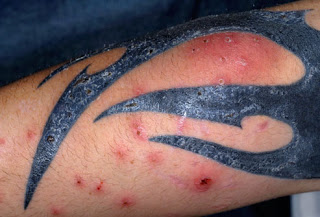
Figura 23. Las reacciones alérgicas pueden mostrar muchos síntomas, incluido enrojecimiento general.
Las reacciones fototóxicas ocurren, aunque no son muy comunes, considerando la cantidad de personas que se hacen tatuajes cada año, donde la fototoxicidad significa tener una reacción al exponerse a la luz solar. Las reacciones inflamatorias causadas principalmente por las tintas aparecen como inflamaciones y erupciones rojas que generalmente ocurren para todos y se espera que desaparezcan dentro de 2 a 4 semanas con la atención y el cuidado adecuados.
La dermatitis causada por reacciones alérgicas a los pigmentos se caracteriza por erupciones cutáneas inflamadas y por la zona afectada que se vuelve escamosa o escamosa. Estas reacciones alérgicas no siempre ocurren inmediatamente después de la aplicación del tatuaje, a veces los efectos pueden retrasarse por meses, incluso años. La picazón y las protuberancias rojas que pueden ser causadas debido a cambios en el clima o la temperatura del cuerpo a menudo ocurren, lo que probablemente requerirá una visita a su dermatólogo o antibióticos.
Los granulomas son una colección de células inmunes conocidas como histiocitos. Los granulomas se forman cuando el sistema inmunitario intenta aislar las sustancias que percibe como extrañas pero que no puede eliminar. Dado que las partículas de tinta del tatuaje son materiales extraños, los granulomas pueden desarrollarse alrededor o dentro del tejido tatuado. Aparte de los granulomas, el agrandamiento de los ganglios linfáticos también se ha informado como un efecto secundario de los tatuajes. Los pigmentos utilizados se filtran en el torrente sanguíneo y se acumulan en los ganglios linfáticos causando inflamaciones dolorosas en estas regiones. La principal causa de preocupación debido a estas inflamaciones es el diagnóstico erróneo del melanoma. En pacientes con riesgo de cáncer, un radiólogo a menudo no puede distinguir entre la tinción de tinta en el ganglio linfático y el crecimiento anormal de tejido.
Otros efectos secundarios del tatuaje tal vez:
- Los hematomas son contusiones que pueden ocurrir debido a la perforación de un vaso sanguíneo durante el proceso de tatuaje y pueden ocurrir como acumulaciones de sangre.
- El queratoacantoma es un tumor de piel caracterizado por una piel inflamada en forma de cúpula que aumenta gradualmente de tamaño y su desarrollo aumenta con los tatuajes.
- La hiperqueratosis, que es un crecimiento excesivo de la queratina en los folículos pilosos, es un ejemplo de crecimiento anormal cuya aparición también dependerá de una persona a otra y también del artista del tatuaje.
- La hiperplasia también puede ocurrir, la hiperplasia es un agrandamiento del órgano debido a la multiplicación anormal de las células.
Dado que las tintas utilizadas para tatuajes contienen metales, ha habido quejas de personas que tienen tatuajes para experimentar una sensación de ardor cuando se les realiza una exploración de MRI. Aunque no se ha verificado de manera concluyente, ha habido informes de que la calidad de la imagen de MRI se ha visto afectada por los pigmentos en las tintas para tatuajes. Una resonancia magnética o una imagen de resonancia magnética crea imágenes del interior del cuerpo mediante campos magnéticos y pulsos de radiofrecuencia. La preocupación por las tintas para tatuajes se debe principalmente a la fuerza magnética que es extremadamente poderosa y puede afectar a las partículas de metal en las tintas. Por lo tanto, la RM realizada para personas con tatuajes requiere más atención.
[:]

